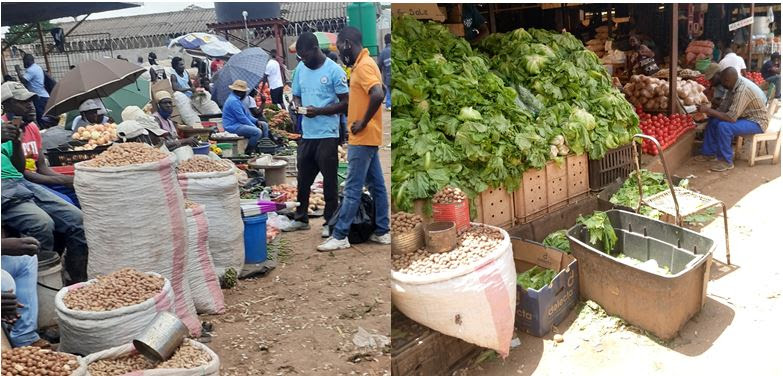By Charles Dhewa
Why does a bumper harvest not get as much attention from governments and development agencies as disasters like droughts and cyclones? When there is a drought, African governments are quick to declare a national disaster so that food aid starts being mobilized from outside with support from development agencies. On the contrary, a bumper harvest does not seem to inspire swift action toward preventing the next drought. In addition, bumper harvests do not receive as much media coverage as famine.
A bumper harvest is more than cereals
What is often ignored by policymakers and development agencies is that a good rainfall season does not only lead to a bumper harvest of cereals but bumper nutrition in the form of a wide range of cultivated crops, livestock, indigenous fruits, fish, and wild animals including edible insects. It follows nutrition-responsive strategies for handling a bumper harvest should certainly go beyond revamping maize silos. Due to a bumper rainfall season, a lot of field crops and horticulture will be produced throughout the year. More than 30% of the farmers will produce all-year-round.
However, issues facing farmers when there is a bumper harvest are national in stature and cannot be tackled by individual farmers or communities. Such issues include poor road network and connectivity to ensure farmers are constantly communicating with the market as well as organizing markets. In addition, a bumper harvest cannot be marketed through buyer monopoly. For instance, it cannot just be about selling to the Grain Marketing Board. Farmers should be given options because some just want to sell a bucket to solve immediate issues. They should not be forced to sell through a bureaucratic system that pays after several months.
The role of markets in managing bumper harvests
In the context of a bumper harvest, most farming communities produce more than can be consumed locally and have to off-load commodities on the market. This means government and development agencies have to understand the capacity and operations of different kinds of markets. The fact that formal markets cannot handle the bulk of the bumper harvest compels governments to support mass markets where the bulk of the commodities find their way from the majority of farmers. Efforts and resources should be directed at revamping and recognizing the aggregation role of mass markets so that they are able to meet the needs of consumers, processors, and other value adders. Building a strong connection between mass markets and formal markets like processors and exporters becomes critical.
The media can play a more meaningful role by covering the entire value chain including markets not just focus on production. For instance, in Zimbabwe, the media is always seen accompanying the minister of agriculture when he is touring big farms and irrigation schemes but the minister does not visit mass markets at all. The Grain Marketing Board which the media covers repeatedly, especially when the same minister tours the grain silos, no longer has a monopoly. It is unfortunate that the only time mass markets are covered in the media is when something negative like an outbreak of cholera happens or when there is suspicion that people in mass markets are too congested to practice social distancing.
Bias towards production also needs to be revisited. A lot of public and private institutions including NGOs are still pouring resources into field days, shows, and other exhibits that are designed to celebrate high production through high yields. Most of these events are confused with markets. If you pour all resources to demonstration sites, field days, and shows, what about markets where commodities end up making a difference between moving out of poverty or staying in poverty for farmers? Although the market contributes more than 90% of the money and other resources squandered on production and field days, it does not receive commensurate support and resources. The fiscus also tends to be more inclined towards production as seen by how more than 90% of the agricultural budget goes to production with markets not even visible in budget lines except parastatal marketing institutions.
Most of the production becomes meaningless if the market is not able to absorb most of the quantities produced. When you produce you need to trade. A holistic focus that recognizes markets as drivers of food and nutrition security should see presidential input schemes and government input support interventions being extended to the market. The best ways of extending presidential schemes or government schemes to the market include establishing cooling and value addition facilities in production zones, grading infrastructure, and other market-related needs so that farmers do not just push all commodities to the market as soon as the marketing season starts because they are afraid the commodities will go bad and be rejected by the market.
The bias towards production also holds sway in the development sector where most consortiums comprising several NGOs continue to work in production which is already showing signs of being over-subscribed. Given that at least 70% of African agriculture is rain-fed, a critical factor for production is the availability of water. This implies, bringing together dozens of NGOs to work in production where there is no water is just a waste of money and other resources like knowledge. As if that is not enough, the NGO sector covers less than 5% of the population, which means 95% of the farmers finance themselves.
There should be a shift in resource allocation towards harvest periods in response to a bumper harvest, the same way development agencies quickly respond to outbreaks of diseases such as cholera and cyclones so that the good harvest is not lost. Development agencies, farmer unions and other actors should adapt quickly rather than treat a bumper year like any other year. Several agricultural companies requesting foreign currency allocation from the Reserve Bank are doing so to import commodities they should procure locally if they had built win-win relationships with mass markets that are the major aggregators of agricultural raw materials.
Importance of treating mass food markets as institutions
Mass food markets are institutions in their own right and require appropriate management skills. It is a colonial mind set to insist that mass food markets should be owned and operated by local authorities like rural district councils and municipalities. The fact that local authorities own the land on which markets are operating does not imply they should also operate the market. Private partnership models between local authorities and the private sector should be explored and solidified because the private sector is good at identifying demand and meeting customer needs.
By insisting that local authorities should operate food markets, governments are persisting with a colonial model. Agricultural markets should also be treated like formal institutions. There is no one playing a watchdog role in food markets run by local authorities, from which the majority of urban residents get their food. While in residential areas, residents are watchdogs for service delivery such as water reticulation and refuse collection, such watchdog role does not extend to mass food markets which are business institutions where residents should be making noise about food safety and hygiene.
The situation is worsened by the fact that government departments do not have the power of oversight over each other. The ministry of agriculture does not have the power to tell the ministry of local government how food should be handled in mass markets under local authorities. Otherwise, the ministry of agriculture, ministry of women’s affairs, ministry of health, ministry of youth as well as industry and commerce would be making noise about the poor handling of agricultural commodities in mass markets because such handling has a bearing on the success of each of these government departments’ mandates. The ministry of health is also silent and far from markets yet the quality of food and how food is handled has a bearing on the health budget.
When government departments do not see their mandates or stakes in food markets, a vacuum is created for NGOs to seek donor funding by writing proposals based on bad things about mass food markets. For instance, instead of capacitating local authorities to execute their mandates, NGOs seek donor funding to provide water and sanitation in mass markets as well as revamp market infrastructure when a more sustainable approach is supporting local authorities. On the production side, NGOs are drilling boreholes and doing work that should be done by local councils instead of giving those resources to councils as part of a permanent solution. It seems the whole development space is being invaded by NGOs, pushing out government departments such as councils and extension services departments.
The power of evidence-based responses
All actors should come together and answer a question like: What can we do the abundant produce from farmers and production zones? In much of Zimbabwe, most commodities like tomatoes, pumpkins, and others are already rotting in farming areas. Some are fetching below their normal value due to market failure and low consumer spending, following lockdowns. When the majority of farmers get less than 30% of the potential value of their commodities, that means they will have lost 70% of potential income – pushing them back to poverty. On the contrary, the price of inputs will obviously not go down.
This is how understanding markets becomes very important. It is not just about farmer unions because more than 80% of farmers do not belong to farmer unions. However, if farmer unions articulate and represent farmers well during a bumper harvest, it is an opportunity for them to mobilize membership towards tangible results and solutions.
Transportation – With respect to the cost of transport, farmers are left to move their own commodities to the market using whatever means at their disposal. It seems the government has no role in facilitating the movement of commodities. Once in a while, the railway system is seen moving coal rather. How can it be used to move agricultural commodities from high production zones to low production zones?
Horticulture – In Zimbabwe, there is no active institution responsible for horticulture. Maize and other grains go to the GMB and its infrastructure but there is no similar board for horticulture. How do we preserve, aggregate and market horticulture commodities as well as facilitate exports when there is no appropriate infrastructure? The new horticulture board is linked to exports and controlled by exporters of selected commodities while the government is just a passenger. The debate at horticulture meetings is dominated by a few actors and does not have a national complexion.
All commodities do very well in a bumper harvest and such commodities include livestock. How are we going to help farmers market goats? Indigenous chickens and fruits also do very well in a bumper harvest. How are we going to store and market commodities in ways that preserve nutritional content? A bumper harvest is so important as to merit a national dialogue on how to harness its benefits. Instead of waiting for national assessments like the second round of the Zimbabwe Vulnerability Assessment Committee (ZIMVAC), there is a need for a national dialogue on the bumper harvest because farmers are already harvesting. More importantly, crops are not harvested at the same time because they are at different stages of ripening.
National readiness for a bumper harvest requires swift evidence-based policy interventions. When marketing is well organized, it will prevent cases where farmers move around looking for markets and consumers travelling long distances looking for commodities and in the process exposing themselves to COVID19 or becoming super spreaders. A bumper year should be turned into good returns. The pros and cons of gazetting prices should be backed by evidence. Evidence from the mass market demonstrates how gazetting maize prices leads to farmers getting lower prices from alternative markets which end up using the gazette prices to benchmark what farmers should get in the open market. Instead of gazetting prices when the size of the markets and their dynamics are unknown, it is better for government to build efficient market systems and supply chains.






